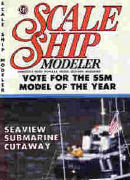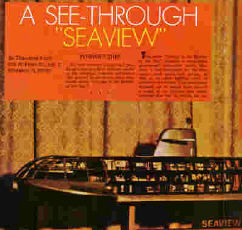
|
Voyage to the Bottom of the Sea |
|
Ted Koch's Cutaway Seaview |
 |
Lots of modelers have tackled Submarine Seaview. Ted Koch is one of the few to create a serious cutaway version. First of all, Ted had to decide on a hypothetical length for Seaview (see Seaview design history. ) He settled on 447 feet. The completed model is 5 feet long, which means that each inch of model is equivalent to 7&1/2 feet of boat. |
| Ted writes, In order to
formulate an authentic rendition of the Seaview, I needed to call upon
informed sources. I wrote to the Irwin Allen studios requesting a
copy of the blueprints depicted in the series, but much to my
disappointment, I received no response. Their floor plan was a source of puzzlement to me throughout the construction of my model. It often conflicted with the "acting sets." (Ah yes, the infamous Irwin Allen inconsistencies.) Ted says, I also relied on other sources for the basic submarine construction and design. |
|
|
Ted wrote to General
Dynamic Corporation, The Department of the Navy, and the Atomic Energy
Commission among others, and received a number of helpful declassified
documents and photos.
|
| Lighting (grain of wheat bulbs) was installed throughout the ship and powered by a D.C. Transformer located at the stern. The first room assembled was the missile room. The starboard wall and control panels were fabricated from illustration board and colored with various media from paint to colored pencils. The sixteen missile tubes were made from wooden dowels. The diving bell winch was made from dowel, black thread and balsa wood. The diving bell was constructed from a combination of old model parts and homemade fabrications. Pipes, machinery and other hardware were inventively installed. Crewmen and officers (Airfix) were purchased from a local model store and appropriately painted. |
|
 |
Ted then started building out the interior from the nose on back. Stained Balsa sheets became paneling. A table and chairs were made from balsa wood and placed near the observation ports. The spiral staircase was made from balsa and cardboard and painted silver. The control room features an array of finely detailed computers and control panels. The transmitting and receiving console in the radio shack is back-lighted. All sorts of neat stuff is creatively wound into the design, including the galley and mess area, the circuitry room and crews quarters among them. On the upper deck, of course, the Admiral's and Captain's quarters along with sick bay and the main armory. The reactor room is fashioned like the one in the series with pulsating back-illumination. |
|
With the interior done, Ted manufactured ribbing for the exposed port side
formed by soaking balsa wood in water and stretching around a contoured
form. This gave an added exterior form to the exposed side of the
model. Added last was a clear plastic cover fitted over the ribs to
protect and preserve the delicate interior. The model is mounted on
a wooden stand with the inscription Seaview. The project took
countless hours over a five-year period to complete.
Hats off to Ted Koch, a man who has a lot more patience than many (certainly more than I). |
|
|
|
|